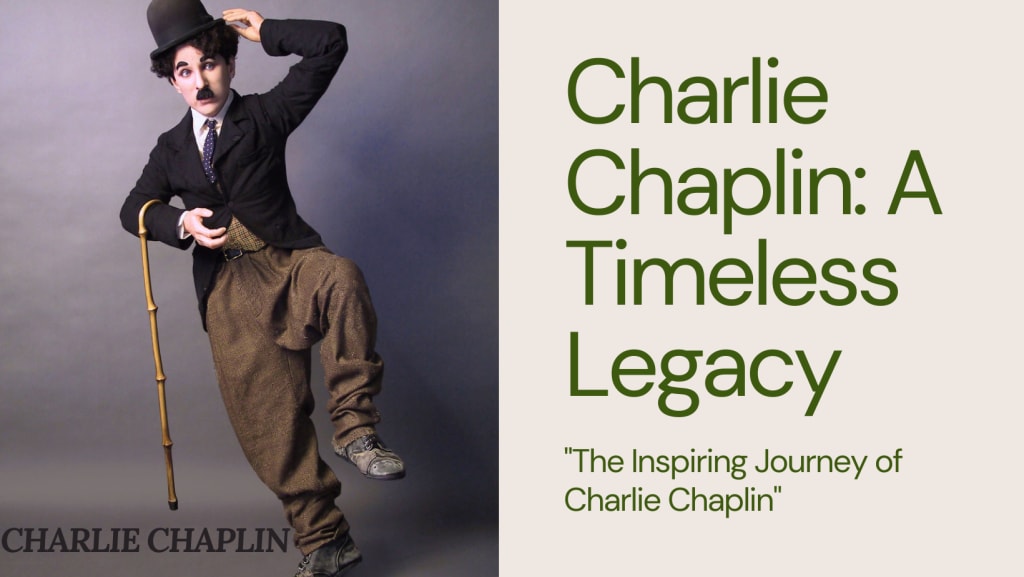Charlie Chaplin: A Timeless Legacy
"The Inspiring Journey of Charlie Chaplin"

Part 1:
The Early Years
Charlie Chaplin's journey began on April 16, 1889, in the bustling city of London, England. Born into a family of entertainers, his parents, Charles and Hannah Chaplin, were music hall performers. However, their unstable marriage and financial struggles led to their separation when Charlie was just a toddler.
Charlie's childhood was far from idyllic. His mother, plagued by mental health issues, was frequently absent from his life. As a result, Charlie and his older half-brother Sydney found themselves in and out of various workhouses and temporary homes. These early experiences of poverty and instability would shape his perspective and fuel his determination to rise above his circumstances.
Despite the hardships, Charlie discovered a natural inclination for performing at a young age. He would imitate his mother's singing and dancing, showcasing his talent for mimicry and physical comedy. These early displays of creativity and innate comedic timing provided a glimpse of the extraordinary talent that lay within him.
Part 2:
Navigating the World of Vaudeville
At the age of eight, Charlie's life took a turn when he secured a spot in the clog-dancing group, The Eight Lancashire Lads. This opportunity marked his introduction to the world of vaudeville, where he honed his performance skills alongside other child actors. Traveling throughout England with the troupe, he gained valuable experience and exposure to different audiences.
Part 3:
A Leap of Faith to America
In 1908, at the age of 19, Charlie took a significant leap of faith by joining Fred Karno's comedy troupe, which was touring the United States. It was during this tour that he caught the attention of American film producer Mack Sennett, who offered him a contract to work in the burgeoning film industry in Hollywood.
Part 4:
The Keystone Years and the Birth of The Tramp
In 1913, Charlie Chaplin made his way to Keystone Studios, where he became a part of Mack Sennett's company. It was here that he developed his iconic character, "The Tramp." Clad in ill-fitting clothes, a bowler hat, and a toothbrush mustache, The Tramp exuded charm, innocence, and resilience. Through physical comedy and exaggerated gestures, Charlie brought the character to life, endearing himself to audiences worldwide.
Part 5:
Evolving Artistry and Creative Control
As Chaplin's popularity skyrocketed, he yearned for more creative control over his work. In 1919, he joined forces with fellow film luminaries Mary Pickford, Douglas Fairbanks, and D.W. Griffith to establish United Artists. This independent production company allowed Chaplin to have complete artistic freedom and control over his films. With this newfound autonomy, he delved into more complex narratives and explored a range of emotions, expanding his artistic horizons.
Part 6:
Silent Film Icon
Throughout the 1920s, Chaplin became an international sensation, captivating audiences with his silent films. Movies such as "The Kid" (1921), "The Gold Rush" (1925), and "The Circus" (1928) showcased his ability to seamlessly blend comedy and pathos. Through his performances, he expressed universal emotions that transcended language barriers and cultural differences.
As Chaplin's popularity grew, he took control of his own career by establishing United Artists, a production company he co-founded with other notable film personalities. This move gave him unprecedented creative freedom to explore new storytelling techniques and push the boundaries of cinema. Notable films such as "The Kid" (1921) and "City Lights" (1931) showcased Chaplin's versatility as both a comedian and a director.
Part 7:
Social Commentary and Controversy
Chaplin's films frequently incorporated social commentary, addressing issues such as poverty, inequality, and the struggles of the working class. In 1940, he released "The Great Dictator," a daring political satire that openly criticized fascism and totalitarianism. The film's powerful final speech, delivered by Chaplin himself, became an iconic moment in cinematic history. However, his outspoken political views drew criticism and led to scrutiny from the U.S. government during the McCarthy era.
Despite his professional success, Chaplin faced personal challenges. His relationships were often fraught with controversy and scandal. He experienced failed marriages, including one with Lita Grey, which ended in a high-profile divorce. Nevertheless, Chaplin remained committed to his craft, undeterred by personal setbacks.
Part 8:
The Transition to Sound
The introduction of sound in cinema posed a new challenge for Chaplin, who had become renowned for his silent films. Initially hesitant to embrace the new technology, he eventually embraced sound in his films. In 1931, he released "City Lights," a poignant romantic comedy that masterfully incorporated synchronized sound effects and a musical score. This film demonstrated Chaplin's ability to adapt and evolve while maintaining the essence of his unique comedic style.
Part 9:
Political Controversy and Personal Turmoil
As Chaplin's fame grew, he faced scrutiny and controversy. His personal life was often tabloid fodder, marked by multiple marriages and relationships with younger women. Moreover, his political leanings and outspoken views drew attention during a time of increasing political tensions. During the McCarthy era and the Red Scare of the 1950s, he faced accusations of communist sympathies, which led to his eventual departure from the United States.
Part 10:
Chaplin's Lasting Legacy
Despite the controversies that surrounded him, Charlie Chaplin's contributions to cinema are immeasurable. He pushed the boundaries of comedy, elevating it to an art form that touched the hearts and minds of audiences worldwide. His films continue to be celebrated as masterpieces, revered for their timeless humor, social commentary, and poignant portrayals of the human condition.
Epilogue:
An Icon for the Ages
On December 25, 1977, Charlie Chaplin passed away at the age of 88, leaving behind a legacy that remains unmatched. His films and his iconic character, The Tramp, are immortalized in the annals of cinematic history. Chaplin's influence on the art of comedy and storytelling is imprinted on every generation of filmmakers, actors, and performers who followed in his footsteps. His life and work serve as a testament to the power of resilience, imagination, and the enduring impact of one man's extraordinary journey.
About the Creator
Enjoyed the story? Support the Creator.
Subscribe for free to receive all their stories in your feed. You could also pledge your support or give them a one-off tip, letting them know you appreciate their work.





Comments
There are no comments for this story
Be the first to respond and start the conversation.